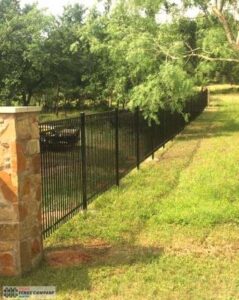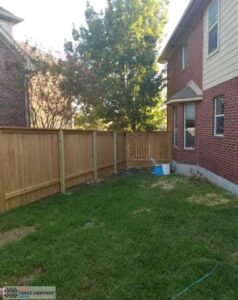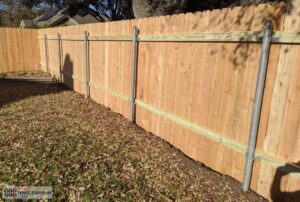Native Plants That Pair with Fences (Low Water, High Impact)
TL;DR
If you want a fence line that looks great and sips water, anchor your design with drought-tough Central Texas natives and micro-habitat logic: tall, airy species to soften fence height, evergreen bones for year-round structure, nectar/seed producers for pollinators and birds, and groundcovers to control splashback along the base. Select deep-rooted perennials and shrubs that can withstand heat, limestone, clay soils, and thrive in part shade. Keep the first 2–3 inches below the bottom boards clear, irrigate sparingly but deeply, and refresh mulch twice a year. The result is a fence that stays clean, lasts longer, and frames a landscape that thrives on neglect.
Table of Contents
ToggleWhy “fence-first” planting works in Central Texas
In Austin, fences do more than mark a boundary—they manage views, wind, deer traffic, pets, and pool safety. A brilliant plant palette, including privacy plants, helps the fence look intentional, protects the base from mud and reflected heat, and turns long runs into layered, living edges that perform even when Stage 2 drought returns. With Atlas Fence Company, you can pair the right species to your fence type, aspect (sun vs. shade), and soil to get a clean, low-water look that lasts.
Design formula: bones, infill, accents, and ground plane

Think of each fence run as a mini-ecosystem built in four layers:
- Bones (structure): Evergreen or semi-evergreen shrubs and small trees that keep the line looking “finished” in winter and provide screening where you need it.
- Infill (seasonal mass): Perennials and ornamental grasses that carry the show from spring to fall with texture and movement.
- Accents (pops): Flowering perennials and subshrubs that punctuate the rhythm—placed where you see them (gates, corners, windows).
- Ground plane (clean edge): Low plants or gravel that stop soil splash and keep the fence base dry. This layer directly extends the life of wood posts and bottom rails.
Spacing rules that save water
- Plant in drifts (groups of 3–7) so roots share moisture zones and leaves shade soil.
- Keep plants 6–12 inches off the fence to maintain airflow.
- Use 3–4 inches of shredded hardwood mulch (keep it off posts and boards).
- Drip lines > spray heads; water deeply and infrequently once plants are established.
Sun vs. shade along Austin fence lines (and how to plant each)
Hot sun (south/west exposures)
- Choose silver/gray foliage (reflects heat) and narrow leaves (reduced transpiration).
- Favor plants that bloom on new growth so you can tidy them hard in winter.
- Insist on drip irrigation or none at all; spray and hot boards lead to mildew and rot.
Go-to natives:
- Shrubs: Texas sage (Leucophyllum frutescens), Cenizo ‘Compacta’, Agarita (Mahonia trifoliolata).
- Grasses: Lindheimer muhly (Muhlenbergia lindheimeri), Gulf muhly (M. capillaris), Little bluestem (Schizachyrium scoparium).
- Perennials: Blackfoot daisy (Melampodium leucanthum), Damianita (Chrysactinia mexicana), Salvia greggii, Mealycup sage (Salvia farinacea).
- Groundcovers: Silver ponyfoot (Dichondra argentea), Frogfruit (Phyla nodiflora) for wildlife edges.
Dappled shade (live oak canopies / north exposures)
- Think evergreen texture and spring color.
- Run a dry shade drip zone; lightly mulch to prevent fungal growth.
Go-to natives:
- Shrubs: Cherry laurel ‘Compacta’ (native-adjacent), Texas mountain laurel (Dermatophyllum secundiflorum), Yaupon holly (Ilex vomitoria ‘Scarlet’s Peak’ for narrow spaces).
- Perennials: Turk’s cap (Malvaviscus arboreus var. drummondii), Cedar sage (Salvia roemeriana), Inland sea oats (Chasmanthium latifolium).
- Groundcovers: Horseherb (Calyptocarpus vialis), Lyreleaf sage (Salvia lyrata) in looser, woodland-adjacent spots.
Native plant shortlists that pair with popular fence styles
Modern cedar privacy (vertical boards, warm tone)

Goal: soften a tall plane without creating mildew traps.
- Bones: Yaupon holly (columnar forms), Agarita for wildlife edges, Wax myrtle in deeper lots.
- Infill: Little bluestem, Gulf muhly, Damianita, Blackfoot daisy.
- Accents: Flame acanthus (Anisacanthus quadrifidus var. wrightii) for hummingbirds; Autumn sage for color bands.
- Ground plane: 6–12″ gravel band plus silver ponyfoot pockets to keep splash off wood.
Black ornamental steel (flat-top picket, see-through)
Goal: keep sightlines open but define space.
- Bones: Cenizo masses set 18–24″ inside the fence to avoid snagging; Upright rosemary (Xeric, native-adjacent) for entry runs.
- Infill: Lindheimer muhly in 5-plant sweeps, Gregg’s mistflower (Conoclinium greggii) for butterflies.
- Accents: Rock rose (Pavonia lasiopetala), Engelmann daisy (Engelmannia peristenia).
- Ground plane: Frogfruit to knit the edge; decomposed granite where you want a crisp, zero-irrigation band.
Welded-wire or fixed-knot mesh (greenbelt edges, deer-aware)
Goal: preserve views, defeat browsing, and still look designed.
- Bones: Mountain laurel clusters (keep 3–4′ off the fence for airflow); evergreen sumac (Rhus virens).
- Infill: Big muhly (M. lindheimeri), Sideoats grama (Bouteloua curtipendula), Salvias.
- Accents: Four-nerve daisy (Tetraneuris scaposa), Zexmenia (Wedelia hispida).
- Ground plane: Rock mulch at low spots; frogfruit or sedges in shaded, damp toes.
Color stories that hold up in summer heat
Austin color needs to read at a distance and resist bleaching in July–August.
- Hill Country Neutrals: silvery greens + buff grasses + white flowers (Blackfoot daisy, white Salvia greggii). Calm, modern, great with cedar.
- Pollinator Pop: Blue/purple salvias, pink rock rose, and the ethereal haze of Gulf muhly in the fall. Works with black steel.
- Evergreen Quiet: glossy mountain laurel + cenizo + dwarf yaupon, punctuated with seasonal color bowls near gates.
Tip: Repeat the same three species for each 20–30 feet of fence to avoid “plant soup.”
Soil & irrigation: limestone slopes vs. clay pockets
Most Austin yards are a patchwork. Treat each fence segment by what’s underfoot:

- Limestone shelves (steep, thin soils):
- Build mounded beds with decomposed granite + compost; choose plants with taproots (salvias, rock rose).
- Use gravelly mulch that dries fast; avoid thick bark against posts.
- Clay pockets (hold water, swell):
- Choose natives tolerant of intermittent wet feet (inland sea oats, Turk’s cap in shade; mealycup sage on shoulders).
- Elevate crowns slightly; run drip long and slow to move water down, not sideways.
- Drainage at the fence:
- Maintain a 2–3″ air gap below bottom boards; don’t bury the fence line in mulch.
- If you have splash issues, lay a 6–12″ stone or DG band right along the fence and plant just outside that zone.
When installing a new line or refreshing an old one, coordinate the planting beds with post spacing, bottom board height, and gate swing clearance during your fence installation to ensure that plants like climbing roses and hardware don’t conflict.
Keeping the fence healthy: airflow, stain schedules, and clean bases
Plants should extend fence life, not shorten it.
- Airflow: Keep mature foliage off boards and posts. Train salvias and shrubs away from contact by early spring pruning.
- Stain cycles: If you have a cedar privacy fence, plan to apply a penetrating finish every 2–3 years; plants that lean against wet boards can trap moisture and dirt. For a smooth process that protects both wood and plantings, align your garden calendar with professional fence staining.
- Clean base: Blow leaves and flower litter out of fence toes in spring and fall; organic piles hold moisture against wood.
- Irrigation aim: Angle or cap emitters so water doesn’t mist the fence face—drip at the root zone only.
Seasonal maintenance calendar (quick and realistic)
January–February
- Hard prune Salvia greggii and mealycup sage to 6–8 inches.
- Cut ornamental grasses to 6–12 inches before spring growth.
- Inspect drip lines; flush and cap any emitters aimed at boards.
March–April
- Top up the mulch to 3–4 inches, keeping it away from the posts.
- Plant new perennials as the soil warms; water deeply on the first day, then weekly until they are established.
- Stain or schedule staining while foliage is still small.
May–June
- Deadhead salvias lightly for repeat bloom; spot water new additions.
- Check the bottom clearance to ensure spring growth has not crept into the fence toe.
July–August
- Resist daily spritzing. If needed, soak deeply every 10–14 days for new plants; established natives can often skip irrigating entirely during normal summers.
- Shear Blackfoot daisy lightly to keep mounding.
September–October
- Enjoy the Gulf muhly show; this is your photo season.
- Plant fall perennials; divide grasses.
- Review stain needs post-summer.
November–December
- Leaf cleanup and drip winterization, if needed.
- Plan any fence repairs while perennials are dormant; it’s the least disruptive time to your plantings.
FAQs
Generally no. In Austin’s heat, most fabrics become water barriers and poke up over time. Use a 3–4″ mulch layer and let groundcovers knit the surface.
Choose low-litter plants and avoid thorny species near footpaths. Gulf muhly, Blackfoot daisy, and Salvia greggii behave well. Keep the required clearance for self-closing gates.
Favor aromatic and tough-leaf plants (Cenizo, Damianita, mountain laurel). If pressure is high near greenbelts, pair planting with an 8-ft, see-through deer-resistant fence; place tempting bloomers closer to the house.
Yes—keep exotics non-invasive and drought-tolerant. The structure should still rely on natives, including evergreen trees, that shrug off heat and cold snaps.
Austin experiences a range of weather conditions, from flash floods to drought. Deep-rooted natives and drip irrigation protect plants, while air gaps, clean bases, and stain cycles protect wood. For a broader primer on weather impacts, see this guide to local climate effects on fences (great context before choosing stain and hardware).
Transform Your Fence Line Into a Native Landscape
 Ready to upgrade a plain fence line into a stunning, low-water showpiece? We’ll help you pair the right fence style with a native plant palette and soil conditions, set up a drip-only watering plan, and schedule finishing and maintenance so your edge stays crisp for years to come. Request a fence + native planting estimate today.
Ready to upgrade a plain fence line into a stunning, low-water showpiece? We’ll help you pair the right fence style with a native plant palette and soil conditions, set up a drip-only watering plan, and schedule finishing and maintenance so your edge stays crisp for years to come. Request a fence + native planting estimate today.
